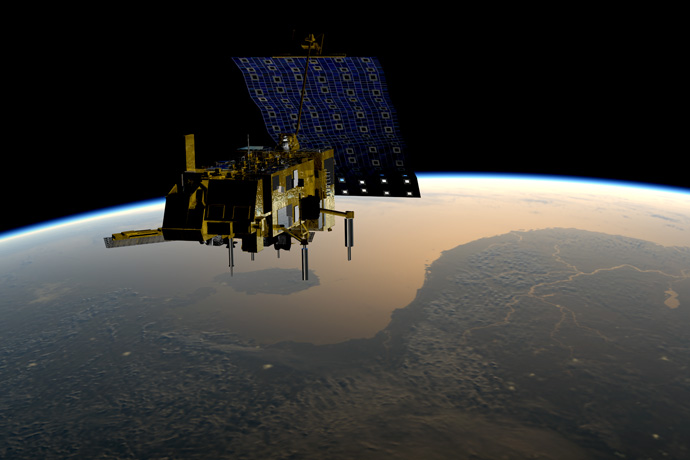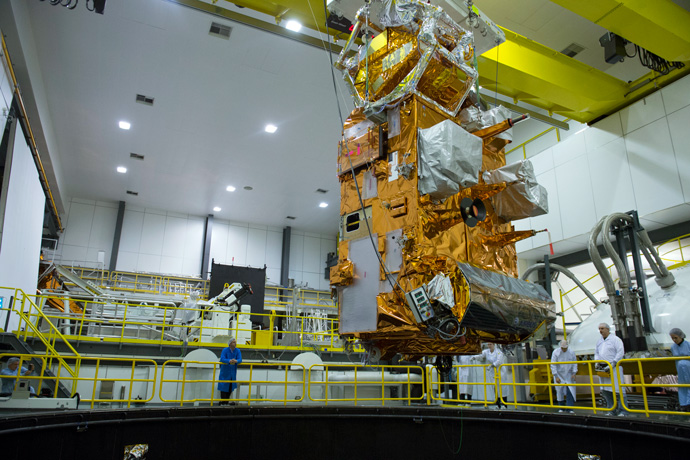

Metop satellites make a vital contribution to numerical weather prediction. (Image: EUMETSAT)
The launch of the Metop-C satellite, scheduled for 7 November 2018, will ensure the continuous supply of crucial data to help initialise numerical weather prediction models for years to come.
Having three Metop satellites in orbit will open the door to innovative uses of the data at ECMWF.
Resilience
Metop-C completes the EUMETSAT Polar System (EPS) of three polar-orbiting satellites that started with the launch of Metop-A in 2006.
The satellite carries the same set of advanced weather observation instruments as Metop-B, launched in 2012, and Metop-A.
The data these satellites provide help to determine the initial conditions on which ECMWF’s weather predictions are based.
Without the data, forecast quality would drop sharply. That is why it is important for the satellite constellation to be resilient: if one satellite fails, another one must be ready to pick up the pieces.
Metop-A and Metop-B were supposed to last only five years. EUMETSAT was able to extend that period significantly.
When Metop-A reaches the end of its life in 2021 or 2022, another resilient constellation of Metop-B and Metop-C will be in place.
“The satellites have exceeded their design lifetime and we extend their operational lifetime as far as we can,” says Alain Ratier, EUMETSAT’s Director-General.
“As a result, for the next three years we will have three Metop satellites in orbit, with added benefits for weather forecasting.”

EUMETSAT Director-General Alain Ratier at the 2018 EUMETSAT Meteorological Conference in Tallinn, Estonia. (Photo: EUMETSAT)
Innovation
The three Metop satellites will be in the same orbit, spaced apart by about 120°. This means they will see the same areas of Earth in quick succession.
As a result, they will be able to extract more information on what is happening in the atmosphere.
“It is, for example, beneficial if the satellites see as much clear sky along their track as possible, or if they see interesting features such as tropical cyclones,” says ECMWF scientist Tony McNally.
“Having three satellites in the same orbit increases the chances of doing so along a given satellite swath.”
The three Metop-satellites will circle Earth in the same orbit. (Video: EUMETSAT)
The higher temporal frequency of measurements along the same track also opens the door to innovative uses of the data.
“By combining measurements from the three satellites, we’ll be able to see how clouds and water vapour move in the atmosphere. Our data assimilation system will be able to translate that into information on winds,” Dr McNally explains.
Wide range of data
To ensure good global coverage, the Metop satellites work in tandem with US satellites.
While the Metops fly in the ‘mid-morning’ polar orbit, the US satellites fly in the complementary ‘afternoon’ orbit.
Metop data are beamed to ground stations twice per orbit, which is about every 50 minutes.
The data is generated by eight main instruments. They provide information on temperature and humidity, atmospheric composition, the ocean and the land surface.
The data can be used for climate studies as well as weather prediction.

The Metop-C instruments had to be tested under the kind of conditions to which they will be subjected in space. Here the payload module is lowered into a vacuum chamber at the European Space Agency’s Test Centre in the Netherlands. (Photo: ESA–G. Porter, CC BY-SA 3.0 IGO)
Meanwhile preparations for the next generation of weather satellites are already well under way.
“Today our main ambition is to prepare for the next generation of satellites and the use of their data, including at ECMWF,” says Alain Ratier.
“These include in particular the geostationary Meteosat third-generation satellites and the polar-orbiting EPS second-generation satellites (EPS-SG).”
The EPS-SG satellites are expected to be one of the most important sources of satellite observations for numerical weather prediction in the timeframe to about 2040.
The first of six satellites in the EPS-SG programme, Metop-SG 1A, is due to be launched in 2021.
More information on the Metop satellites and the EPS-SG programme is available on the EUMETSAT website.
